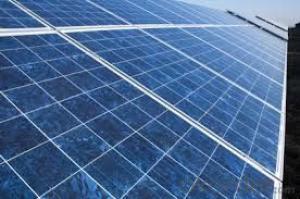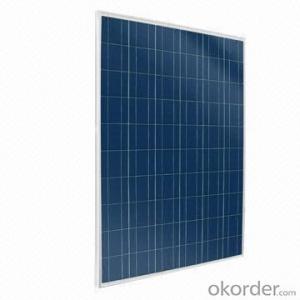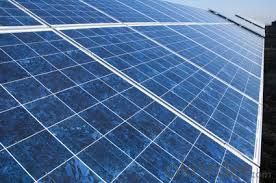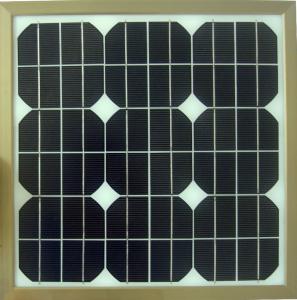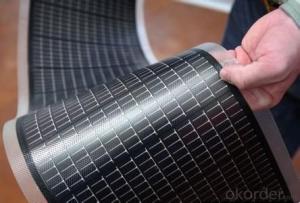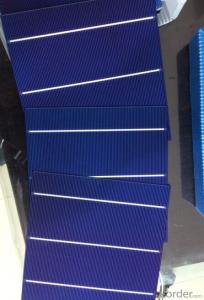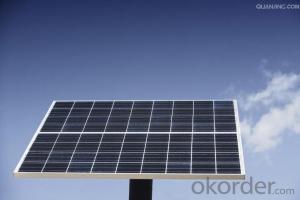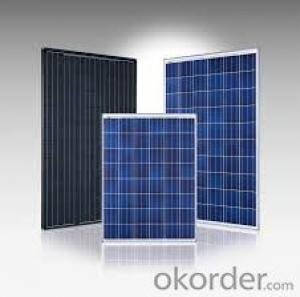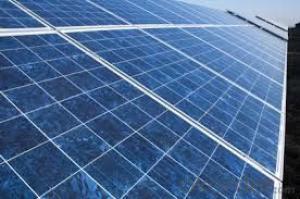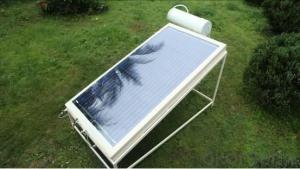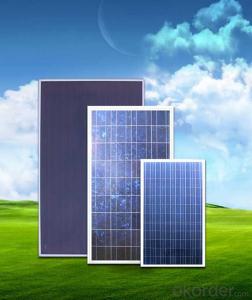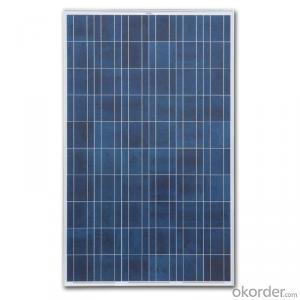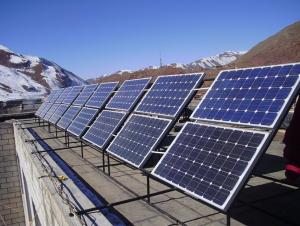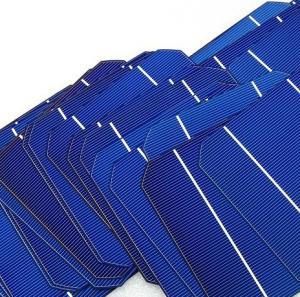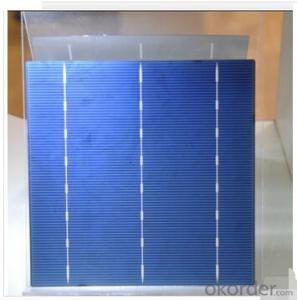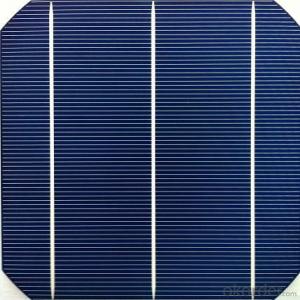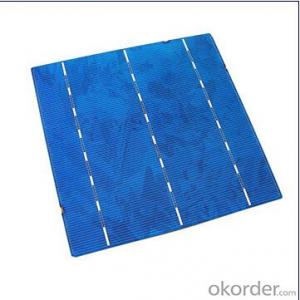Clear Solar Cells Polycrystalline Solar Panel with Factory Price High Efficiency CNBM
- Loading Port:
- Qingdao
- Payment Terms:
- TT OR LC
- Min Order Qty:
- 10 set
- Supply Capability:
- 300000 set/month
OKorder Service Pledge
OKorder Financial Service
You Might Also Like
Polycrystalline Solar Modules
CNBM offers a range of small, medium and large polycrystalline solar modules, designed for a range of requirements.
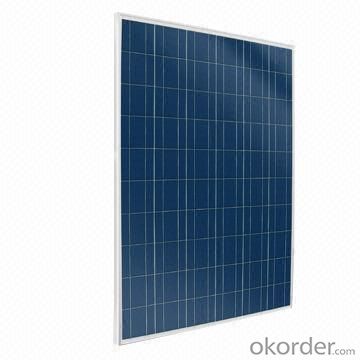
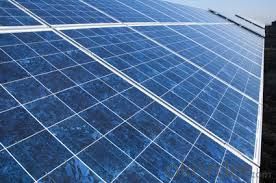
Specifications:
Tolerance | +/-3% |
Cell | Polycrystalline silicon solar cells (156 x 156mm) |
N0. of Cells | 60 (10 x 6) |
Dimension of Modules (mm) | 1650 x 990 x 40 |
Weight (kg) | 25.5 |
Limits:
Operating Temperature | -40~+85? |
Storage Temperature | -40~+85? |
Maximum System Voltage | 1000 VDC max. |
Hail Impact | Diameter of 28mm with impact speed |
Temperature and Coefficients:
NOCT | 48C+/-2? |
Voltage temperature coefficient (%/K) | -0.35 |
Current temperature coefficient (%/K) | 0.05 |
Power temperature coefficient (%/K) | -0.45 |
Characteristics:
Model: | SGM-200P | SGM-210P | SGM-220P |
Max-power voltage Vmp (V) | 29.2 | 29.4 | 29.41 |
Max-power current Imp (A) | 6.85 | 7.14 | 7.48 |
Open-circuit voltage Voc (V) | 36.5 | 36.69 | 36.9 |
Short-Circuit Current Isc (A) | 7.28 | 7.6 | 7.93 |
Max-power Pm(W) | 200 | 210 | 220 |
Model: | SGM-230P |
Max-power voltage Vmp (V) | 29.8 |
Max-power current Imp (A) | 7.72 |
Open-circuit voltage Voc (V) | 37.31 |
Short-Circuit Current Isc (A) | 8.19 |
Max-power Pm(W) | 230 |
STC: Irradiance 1000W/m2, module temperature 25?, AM-=1.5
Poly Crystalline Solar Panels Specifications Range
Maximum Power (Pm) | Dimension | Weight | Operating Voltage (Vmp) | Operating Current (Imp) | Open Circuit Voltage (Voc) | Short Circuit Current (Isc) |
0.45W | 140x80x10mm | 0.08kg | 3.3V | 150mA | 4.6V | 160mA |
1.0W | 162x140x10mm | 0.16kg | 7.5V | 150mA | 10.3V | 160mA |
4.5W | 269x251x23mm | 0.8kg | 16.5V | 0.27A | 20.5V | 0.3A |
10W | 420.1×268.9×22.6mm | 1.92kg | 17.5V | 0.58A | 20.5V | 0.6A |
20W | 425x502x50mm | 3.0kg | 16.8V | 1.19A | 21.0V | 1.29A |
30W | 593x502x22.6mm | 3.9kg | 16.8V | 1.78A | 21.0V | 1.94A |
40W | 655x537x50mm | 5.75kg | 17.3V | 2.31A | 22.1V | 2.54A |
50W | 839x537x50mm | 6.0kg | 17.5V | 2.9A | 21.8V | 3.17A |
65W | 1111x502x50mm | 7.2kg | 17.6V | 3.69A | 22.1V | 3.99A |
80W | 1204x537x50mm | 7.7kg | 17.6V | 4.55A | 22.1V | 4.8A |
- Q: Can solar cells be used on vehicles?
- Yes, solar cells can be used on vehicles. They can be installed on the roof or other surfaces of vehicles to convert sunlight into electricity, which can then be used to power various vehicle systems such as lights, air conditioning, or even the propulsion system.
- Q: Can solar cells be used at night?
- No, solar cells cannot generate electricity at night because they rely on sunlight to produce energy.
- Q: What is the role of solar cells in reducing carbon emissions?
- Solar cells play a vital role in reducing carbon emissions by converting sunlight into clean, renewable energy. As solar cells generate electricity with no greenhouse gas emissions, they help to offset the use of fossil fuels for power generation, which is a major contributor to carbon emissions. By harnessing the sun's energy, solar cells provide a sustainable alternative and help to mitigate climate change by reducing our reliance on carbon-intensive sources of power.
- Q: How do solar cells perform in high altitude regions?
- Solar cells perform more efficiently in high altitude regions due to several factors. Firstly, high altitudes often have less air pollution, which means there are fewer particles in the air that can block or scatter sunlight. This allows solar cells to receive more direct sunlight, resulting in increased energy production. Additionally, solar cells operate more efficiently at lower temperatures, and high altitudes generally have cooler temperatures compared to lower elevations. Cooler temperatures help to reduce heat-related losses and improve the overall performance of solar cells. Therefore, solar cells in high altitude regions tend to generate more electricity and have higher conversion rates.
- Q: Can solar cells be used in air conditioning systems?
- Yes, solar cells can be used in air conditioning systems. Solar-powered air conditioning systems utilize solar panels to generate electricity which is then used to power the air conditioning unit. This allows for a more sustainable and environmentally friendly cooling solution.
- Q: What should I know about the Crystalline silicon photovoltaic cells?
- Crystalline silicon photovoltaic cells work by using crystalline silicon photovoltaic effect and power of the solar cell in generating the electrical power. It is not only used in the daily life but also in the industrail markets.
- Q: Can solar cells be used to power outdoor lighting systems?
- Yes, solar cells can be used to power outdoor lighting systems. Solar cells convert sunlight into electricity, which can be stored in batteries and used to power outdoor lights when the sun goes down. This allows for a sustainable and energy-efficient lighting solution, especially in remote or off-grid areas.
- Q: What happens to excess electricity generated by solar cells?
- Excess electricity generated by solar cells can be stored in batteries for later use, or it can be fed back into the grid to be used by other consumers.
- Q: Is there any easy way to make a solar cell? I want to make a DIY solar cell with my child at home.
- I sent a private message to you about my personal experience of diy solar cell.
- Q: Can solar cells be used for powering satellites?
- Yes, solar cells can be used for powering satellites. In fact, they are one of the most common and efficient methods of generating electricity in space. Solar cells convert sunlight directly into electricity, which is then used to power various systems and instruments onboard a satellite.
Send your message to us
Clear Solar Cells Polycrystalline Solar Panel with Factory Price High Efficiency CNBM
- Loading Port:
- Qingdao
- Payment Terms:
- TT OR LC
- Min Order Qty:
- 10 set
- Supply Capability:
- 300000 set/month
OKorder Service Pledge
OKorder Financial Service
Similar products
Hot products
Hot Searches
Related keywords
